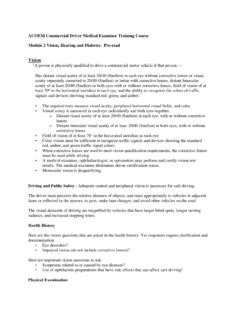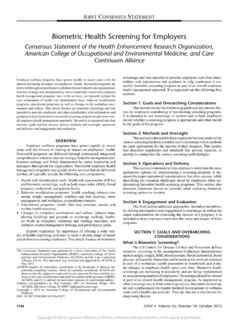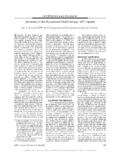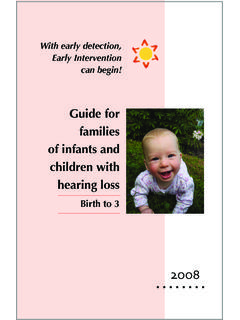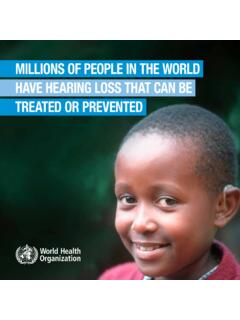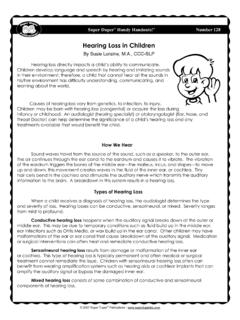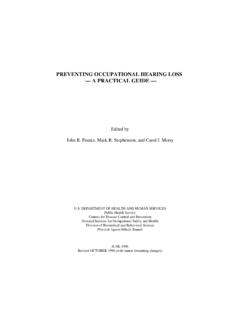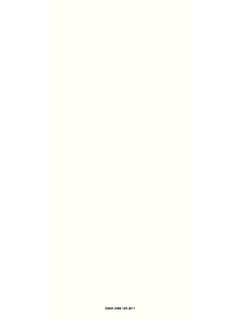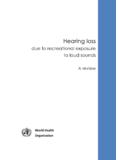Transcription of Occupational Noise-Induced Hearing Loss
1 ACOEM GUIDANCE STATEMENT. Occupational Noise-Induced Hearing loss ACOEM Task Force on Occupational Hearing loss D. Bruce Kirchner, MD, Col. Eric Evenson, MD, Robert A. Dobie, MD, Peter Rabinowitz, MD, James Crawford, MD, Richard Kopke, MD, and T. Warner Hudson, MD. Noise-Induced Hearing loss (NIHL) contin- supervisors in the 1983 Hearing Conserva- loss (presbycusis) without access to pre- ues to be one of the most prevalent occupa- tion The responsibilities of the vious tional conditions and occurs across a wide professional supervisor can be found in the The exact location of the notch de- spectrum of industries. Occupational hear- ACOEM position statement The Role of pends on multiple factors including the ing loss is preventable through a hierarchy of the Professional Supervisor in the Audiomet- frequency of the damaging noise and controls, which prioritize the use of engineer- ric Testing Component of Hearing Conserva- size of the ear canal.
2 Ing controls over administrative controls and tion Programs. 3 Responsibilities include in- In early NIHL, the average Hearing personal protective equipment. The occupa- terpretation of audiograms, work-relatedness thresholds at the lower frequencies of tional and environmental medicine (OEM) determinations, referral of problem cases, 500, 1000, and 2000 Hz are better than physician works with management, safety, quality oversight of audiometric testing, and the average thresholds at 3000, 4000, industrial hygiene, engineering, and human determination of the effectiveness of the hear- and 6000 Hz, and the Hearing level at resources to insure that all components of ing conservation program.
3 8000 Hz is usually better than the deep- Hearing loss prevention programs are in This position statement clarifies cur- est part of the notch. This notching is in The OEM physician should empha- rent best practices in the diagnosis of NIHL. contrast to presbycusis, which also pro- size to employers the critical importance On the basis of current knowledge, ACOEM duces high-frequency Hearing loss but in of preventing Hearing loss through controls proposes the following update of a previ- a down-sloping pattern without recovery and periodic performance audits rather than ous position statement4 regarding the distin- at 8000 just conducting audiometric testing.
4 Never- guishing features of Occupational NIHL. Although Occupational Safety and theless, audiometric testing, besides docu- Health Administration (OSHA) does not menting the permanent loss of Hearing , can DEFINITION require audiometric testing at 8000 Hz, be of value in the identification of Hearing Occupational NIHL, as opposed to oc- inclusion of this frequency is highly rec- loss at a time when early preventive interven- cupational acoustic trauma, is Hearing loss ommended to assist in the identification tion is possible. The American College of that is a function of continuous or intermit- of the noise notch as well as age-related Occupational and Environmental Medicine tent noise exposure and duration, and which Hearing loss .
5 (ACOEM) believes that OEM physicians usually develops slowly over several years. noise exposure alone usually does not pro- should understand a worker's noise exposure This is in contrast to Occupational acoustic duce a loss greater than 75 dB in high history and become proficient in the early trauma, which is characterized by a sudden frequencies and greater than 40 dB in detection and prevention of NIHL. change in Hearing as a result of a single ex- lower frequencies. Nevertheless, individ- posure to a sudden burst of sound, such as uals with non-NIHL, such as presbycusis, THE OEM PHYSICIAN AS an explosive blast. The diagnosis of NIHL is may have Hearing threshold levels in ex- PROFESSIONAL SUPERVISOR made by the OEM physician, by first taking cess of these values.
6 OF THE AUDIOMETRIC into account the worker's noise exposure his- Hearing loss due to continuous or intermit- tory and then by considering the following tent noise exposure increases most rapidly TESTING COMPONENT OF A during the first 10 to 15 years of exposure, characteristics. Hearing CONSERVATION and the rate of Hearing loss then decelerates PROGRAM CHARACTERISTICS as the Hearing threshold increases. This is The OEM physician also plays a The principal characteristics of occu- in contrast to age-related loss , which ac- critical role in the prevention of NIHL pational NIHL are as follows: celerates over time. by serving as a professional supervisor of Available evidence indicates that previ- the audiometric testing component of hear- It is always sensorineural, primarily affect- ously noise -exposed ears are not more sen- ing conservation programs.
7 The Occupa- ing the cochlear hair cells in the inner ear. sitive to future noise exposure. tional Safety and Health Administration It is typically bilateral, since most noise There is insufficient evidence to conclude defines a requirement for professional exposures are symmetric. that Hearing loss due to noise progresses Its first sign is a notching of the au- once the noise exposure is discontinued. This guidance article was prepared by the Ameri- diogram at the high frequencies of 3000, Nevertheless, on the basis of available hu- can College of Occupational and Environmental 4000, or 6000 Hz with recovery at 8000 man and animal data, which evaluated the Medicine's Task Force on Occupational Hearing normal recovery process, it is unlikely that loss .
8 The authors and members of the task force This notch typically develops at one of such delayed effects ,9. are D. Bruce Kirchner, MD; Col. Eric Evenson, The risk of NIHL is felt to be low at expo- MD; Robert A. Dobie, MD; Peter Rabinowitz, these frequencies and affects adjacent MD; James Crawford, MD; Richard Kopke, MD; frequencies with continued noise expo- sures below 85 dB (8-hour time-weighted and T. Warner Hudson, MD. sure. This, together with the effects of average) but increases significantly as ex- Address correspondence to ACOEM: info@ aging, may reduce the prominence of posures rise above this Continuous noise exposure throughout the Copyright C 2012 by American College of Occupa- the notch.
9 Therefore, in older individ- tional and Environmental Medicine uals, the effects of noise may be difficult workday and over years is more damaging DOI: to distinguish from age-related Hearing than interrupted exposure to noise , which 106 JOEM r Volume 54, Number 1, January 2012. Copyright 2012 Lippincott Williams & Wilkins. Unauthorized reproduction of this article is prohibited. JOEM r Volume 54, Number 1, January 2012 Occupational Noise-Induced Hearing loss permits the ear to have a rest period. At ric, which can practically estimate such a sociated with Hearing loss are depres- the present time, measures to estimate the hazardous noise ,19 sion, social isolation,25 and increased risk health effects of such intermittent noise are Animal models suggest that exposure to of Workers with evidence of controversial.
10 Ototoxic agents, such as solvents (no- Hearing loss require an individualized eval- Real world attenuation provided by hear- tably styrene, methylstyrene, toluene, p- uation that takes into account both the need ing protective devices may vary widely xylene, ethylbenzene, n-propylbenzene, to communicate safely and effectively and between individuals. The noise -reduction trichloroethylene, and n-hexane), may act the need for protection from additional rating of Hearing protective devices used in synergy with noise to cause Hearing loss . damage due to noise . by a working population is expected Asphyxiants (carbon monoxide and hydro- Because Hearing loss due to noise is ir- to be less than the laboratory-derived gen cyanide), some nitriles (such as acry- reversible, early detection and interven- ,12 Hearing protective devices lonitrile), and metals (lead, mercury, and tion is critical to prevention of this con- should provide adequate attenuation to tin) have also been implicated as causing dition.

